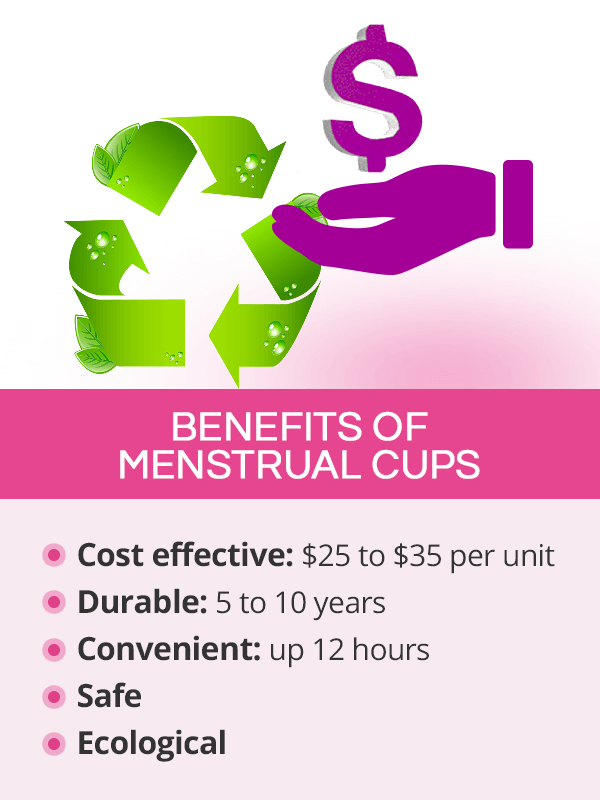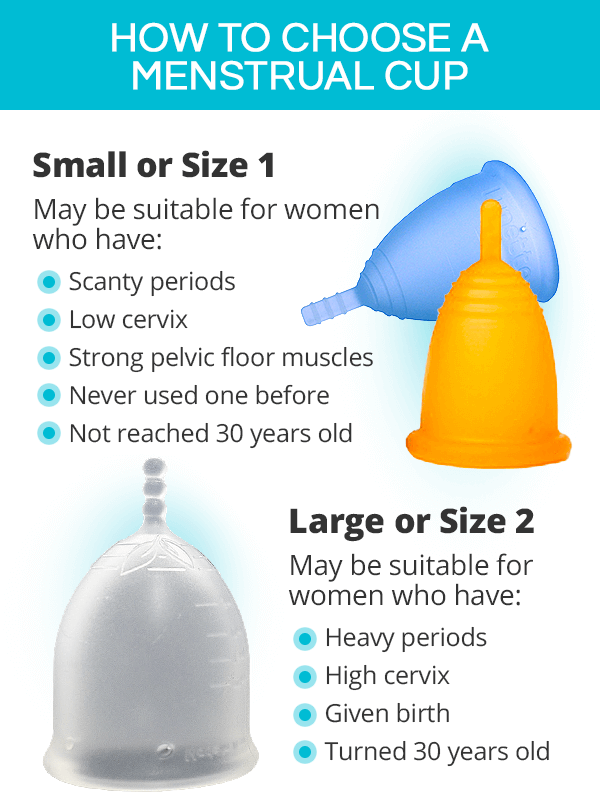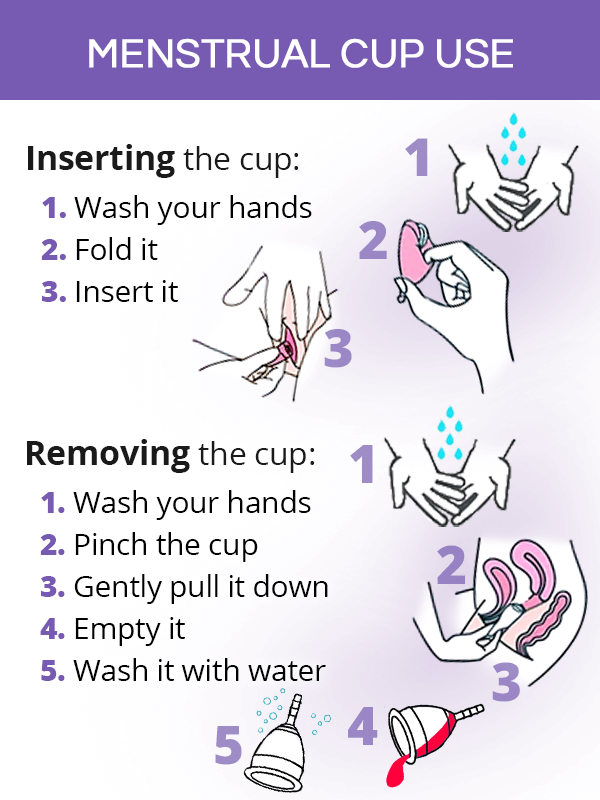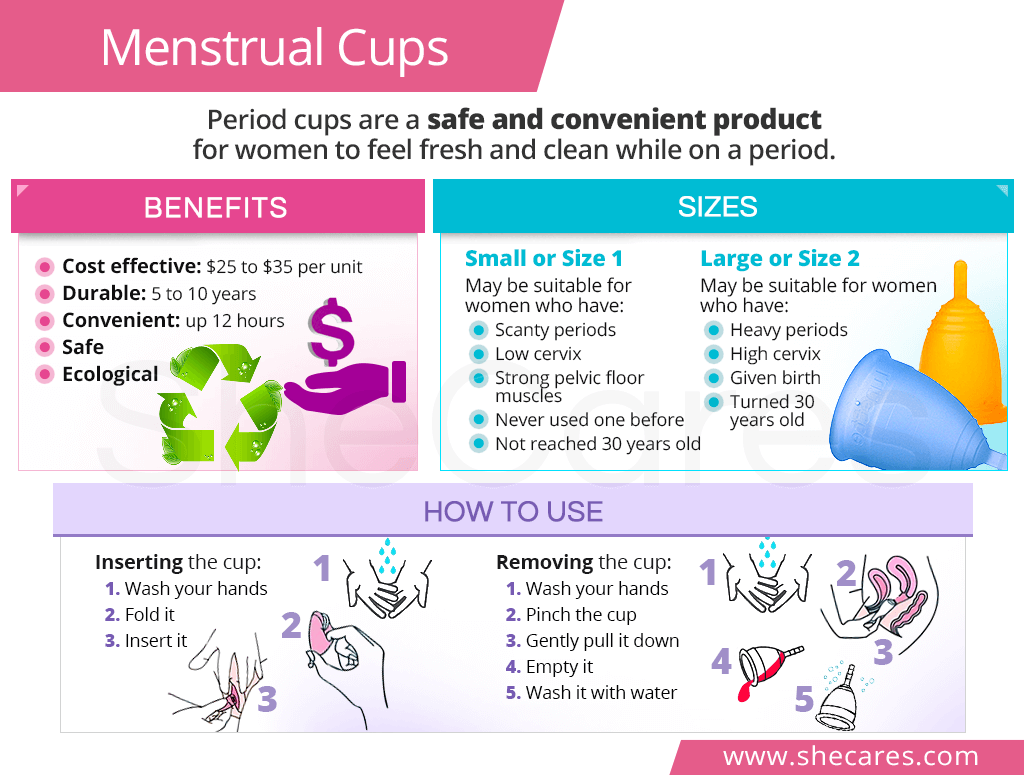What are Menstrual Cups?

Menstrual cups are reusable, flexible devices designed to be inserted into the vagina during a period to collect menstrual discharge and prevent its leakage out of the body. They do not absorb the blood as tampons or pads do.
They are shaped like a bell with a short stem and are mainly made with medical-grade silicone or rubber.
Benefits of Menstrual Cups
Women using menstrual cups praise them for a variety of reasons, including the following:
Cost effectiveness. Menstrual cup cost ranges between $25 to $35. While the initial price is higher than that of tampons or menstrual pads, reusable period cups offer savings in the long-term.
Durability. With proper use, menstrual cups are advertised to last for at least five and up to 10 years.
Convenience. While it may vary according to a woman's flow, menstrual cups offer protection for as long as 12 hours without having to be changed.1
Safety. Unlike tampons, menstrual cups have not been found to disturb the vaginal flora or increase infection risk. Although rare and poorly documented, period cups increase the risk of toxic shock syndrome (TSS).2
Environmentally-friendly. Since a reusable period cup can last a woman for several years, it contributes much less to environmental pollution than disposable period products.
How to Choose a Menstrual Cup

There are a number of criteria women may go by when choosing the right period cup for their needs, including the cup's length or diameter as well as a woman's age, reproductive history, or menstrual flow.
While there is no standard naming system, most brands offer two menstrual cup sizes, including the following:
Mini/Small/Size 1 Menstrual Cups
These menstrual cups typically measure between 1.4 - 1.7 inches (35 to 43 mm) in rim's diameter and hold two to three tampons' worth of menstrual blood.3 They are generally suitable for women who have:
- Scanty periods (or are in the last few days of a period)
- Low cervix
- Petite physique
- Never used a period cup before
- Strong pelvic floor muscles
- Not turned 30 years old (e.g. teens)
Regular/Large/Size 2 Menstrual Cups
These menstrual cups generally measure between 1.7 - 1.9 inches (43 to 48 mm) in rim's diameter and hold three to four tampons' worth of menstrual fluid.4 They are usually suitable for women who have:
- Heavy periods (or are in the first few days of a period)
- High cervix
- Given birth
- Turned 30 years old
Several brands expand their selection to three or four different sizes and levels of firmness. Because of the discrepancy between brands as well as variations in women's period needs, it may take a few trials to find the best menstrual cup.
Menstrual Cup Use

To understand how does a menstrual cup work and how to use it with peace of mind, it is worth having a basic understanding of the anatomy of the vagina.
How Does a Period Cup Work
A menstrual cup's design takes advantage of the fact that the vagina is shaped like hollow tube, with the opening on one end and the cervix - from which menstrual blood is released - on the other. Once inserted, the cup creates a suction seal against the vaginal walls and is held in place by them.
How to Insert a Menstrual Cup
When inserting a menstrual cup, itis important to practice proper hand washing and follow these steps:
- Find the position that works best, including squatting or standing with one leg raised.
- Fold the cup (there are several folding methods to try in order to ease insertion).
- Insert the folded cup about half an inch into the vagina, with the stem pointing downwards. A menstrual cup is usually positioned lower than a tampon.
Removing a menstrual cup should also begin with hand washing, followed by these steps:
- Find the best position, including squatting or standing with one leg raised
- Gently pinch the bottom of the cup to release the seal between the cup and the vaginal walls.
- With a wiggly motion and holding the cup upwards, slowly pull it down out of the vagina.
- Empty the cup into the toilet.
- Wash the cup with warm water and mild soap.
- If needed, insert it back into the vagina.
In between periods, a menstrual cup should be properly sterilized in boiling water and stored in the container it came with or another breathable container, such as a cotton pouch.
Menstrual Cups Leakage
If properly inserted and changed as often as necessary, menstrual cup leakage is unlikely, but not impossible. The following reasons might make it more likely to experience accidental leaks:4
- The cup is not fully open in the vagina or is incorrectly placed.
- The cup's size is not well matched with a woman's flow.
- The uterus is unusually shaped.
- A woman has very heavy periods.
- The cup is overfilled.
As such, understanding one's menstrual patterns, following instructions, and finding the right size is key to using menstrual cups leakage-free.
Key Takeaways
When considering switching to menstrual cups, most women naturally have some concerns regarding their efficacy and safety. They are marketed as a reliable, cost effective, and safe period product and an ecological alternative to disposable pads and tampons. With a few exceptions, most brands offer their menstrual cups in two sizes to fit every woman's period needs. They work by creating a suction seal in the vaginal canal, collecting menstrual discharge for up to 12 consecutive hours. Although it may take time to getting accustomed to their usage and finding the right fit, using menstrual cups is typically leakage-free, offering women a safe and convenient product to feel fresh and clean while on a period.
Sources
- Cleveland Clinic. (2015). Tired of Tampons? Here are Pros and Cons of Menstrual Cups? Retrieved June 1, 2020 from https://health.clevelandclinic.org/tired-of-tampons-here-are-pros-and-cons-of-menstrual-cups/
- Mayo Clinic. (2020). What can you tell me about the menstrual cup? Retrieved June 1, 2020 from https://www.mayoclinic.org/healthy-lifestyle/womens-health/expert-answers/menstrual-cup/faq-20058249
- Official Publication of The College of Family Physicians of Canada. (2011). FLOW. Multicentre randomized controlled trial comparing tampons with menstrual cups. Retrieved June 1, 2020 from https://www.ncbi.nlm.nih.gov/pmc/articles/PMC3114692/
- Planned Parenthood. (n.d.). How do I use tampons, pads, period underwear, and menstrual cups? Retrieved June 1, 2020 from https://www.plannedparenthood.org/learn/health-and-wellness/menstruation/how-do-i-use-tampons-pads-and-menstrual-cups
- The Obstetrician &Gynaecologist. (2004). Quantification of menstrual blood loss. Retrieved June 1, 2020 from https://obgyn.onlinelibrary.wiley.com/doi/pdf/10.1576/toag.6.2.88.26983
- University of Michigan. (2019). Menstrual Cups. Retrieved June 1, 2020 from https://www.mottchildren.org/health-library/abs2234
Footnotes:
- Mayo Clinic. (2016). Menstrual cups vs. tampons: Things you might not know about the cup. Retrieved June 1, 2020 from https://www.mayoclinichealthsystem.org/hometown-health/speaking-of-health/menstrual-cups-vs-tampons-things-you-might-not-know-about-the-cup
- American Society for Microbiology. (2018). Impact of Currently marketed Tampons and Menstrual Cups on Staphylococcus aureus Growth and Toxic Shock Syndrome Toxin 1 Production In Vitro. Retrieved June 1, 2020 from https://aem.asm.org/content/84/12/e00351-18.abstract
- Medscape. (2019). Are Menstrual Cups a Safe Option for Women? Retrieved June 1, 2020 from https://www.medscape.org/viewarticle/916980
- The Lancet. (2019). Menstrual cups use, leakage, acceptability, safety, and availability: a systematic review and meta-analysis. Retrieved June 1, 2020 from https://www.thelancet.com/journals/lanpub/article/PIIS2468-2667(19)30111-2/fulltext
